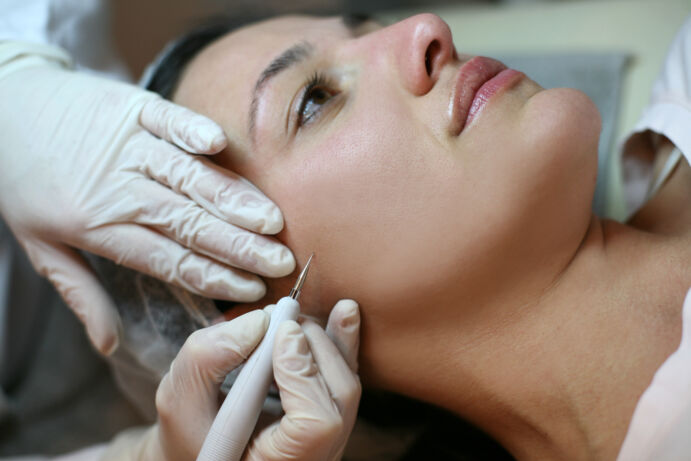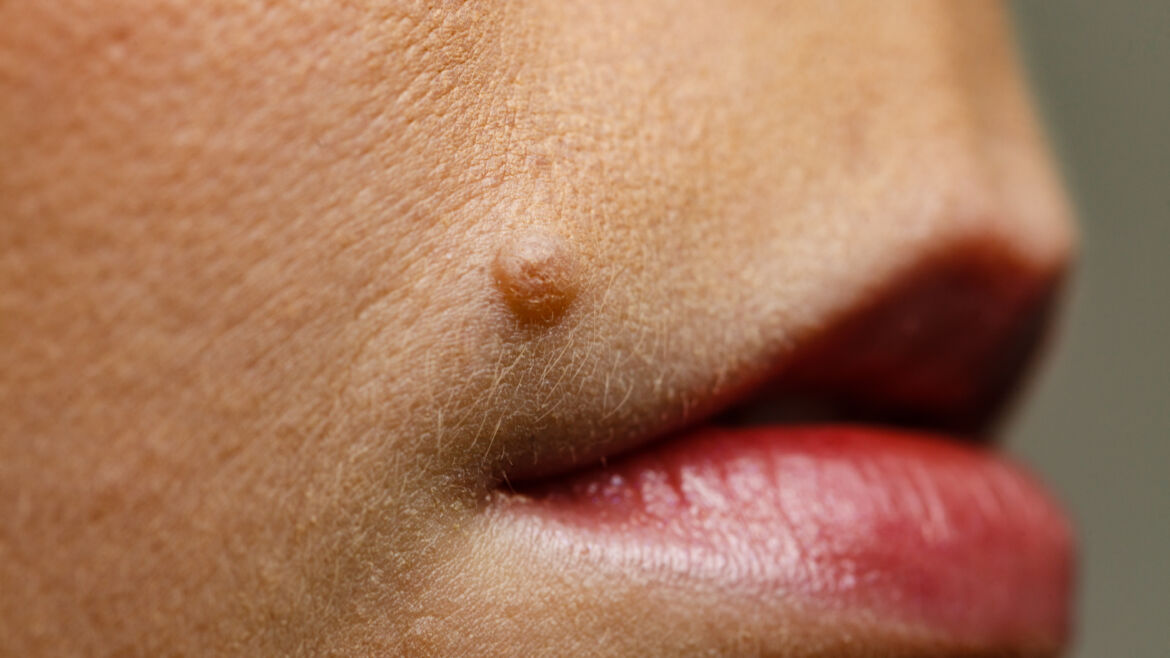Moles or nevus are clusters of pigmented cells called melanocytes that appear as flat dark spots or superficial growths on the skin. They can be pink, blue, red, tan, brown or black and look smooth or wrinkled. Sometimes hairs grow through moles.
These moles can appear anywhere on the skin. They develop during early childhood or adolescence, and can form a birthmark. While they are mostly harmless, they can still lead to worry and become a major aesthetic concern for many individuals. Moreover, some moles and warts cause inconvenience by frequently getting cut whilst shaving or catching when putting on clothing leading to pain and irritation. In such cases, mole removal by a doctor is the best way to have your concern resolved.
Is Your Mole Causing You Concern?
Although skin lesions such as moles, warts and skin tags are common and harmless, they can be unsightly and affect the look and appearance of a person. In particular moles become a concern when they have irregular shapes, appear raised and have larger diameters. Removal of these moles once and for all is likely going to be the only way to resolve this issue.
If you have decided to get your moles treated, it is best to visit a private clinic in the UK to have them removed as soon as possible. Mole removal is not an extensive procedure, and it usually takes only a few minutes. Your doctor will carefully listen to your concern, evaluate your skin and suggest an appropriate plan to safely remove them.
However, if you are waiting to diagnose and remove your mole in the NHS, it can be a lengthy process. The NHS no longer removes skin lesions such as moles, warts and skin tags if they are not considered potentially cancerous or life-threatening. This means that the NHS will not remove moles for purely cosmetic reasons. In the NHS your GP will examine the mole and refer you to a dermatologist for further inspection if they are unsure what it could be. If the mole is suspected to be cancerous or pre-cancerous, you will usually be referred to a clinic called the 2 week wait skin clinic. As the name suggests you will usually be seen within two weeks to have it assessed and potentially treated. Visiting a private skin clinic will likely be the quickest and most effective option without delay for non cancerous moles and aesthetic purposes.
Treatment Methods for Mole Removal
There are many safe and effective treatment options available to remove unsightly stubborn skin lesions and improve the appearance of your skin.

Curettage
Curettage mole removal is a non-invasive procedure in which doctors use a spoon-shaped instrument that has a sharp edge to remove superficial skin lesions. It effectively removes moles, warts and skin tags that have clear boundaries. Curettage is usually used together with cautery. Cautery is a heat-induced haemostasis technique. It typically uses a hot wire, electrodessication or electrofulguration to stop bleeding and prevent infection. It also helps remove any unwanted remaining tissue in the skin lesion.
The procedure begins by injecting a local anaesthetic surrounding the lesion to numb the area and then scrape off the skin lesion. You may feel a slightly mild pushing sensation that does not hurt. Soon after the procedure, your doctor will apply a dressing.
Hyfrecator
Hyfrecation is a safe and effective electrosurgical procedure that aids in removing skin tags and moles from the skin quickly. In this method, the electrosurgical instrument, Hyfrecator uses a low-power, high-frequency electric current to selectively destroy unwanted skin growth. It burns off the moles or skin tags, leaving behind a clean superficial wound that heals quickly with minimal scarring.
The treatment is effective for both superficial and deep tissue removal and is generally painless as your doctor will apply a local anaesthetic. Moreover, it takes only a few minutes, so you may experience only a minimum level of discomfort that comes with the heat. Sometimes, it can take a few sessions to remove persistent skin tags and moles.
Shave Excision
This is best for moles and skin lesions that are protruding on the skin. Doctors use a small and sharp bladed instrument called a scalpel to shave off the protruding mole under a local anaesthetic. This procedure does not require stitching, but the treated area will leave a pink scar that fades with time. The wound may take up to 6 weeks to heal completely.
Excision
Surgical excision is best for moles that lie flat and deep within the skin. Your doctor will make a deeper incision, which also involves removing a small margin of the surrounding skin to remove the lesion completely and stitch it to cover the wound. Before the incision, your doctor will numb the area by injecting a local anaesthetic.

Laser Mole Removal
Laser is a non-invasive procedure that does not involve cutting or burning the skin. In this procedure, a burst of light radiation is directed towards the skin lesion that breaks down and dissipates the skin cells. It is convenient and painless and usually requires two or three sessions to completely remove the mole without scaring. It is also effective in removing a group of moles at the same time.
Cryotherapy
Cryotherapy is another effective non-invasive mole removal procedure. It uses liquid nitrogen to freeze and destroy skin lesions through an instrument called a Cryopen. The treatment only takes a few seconds and can be reapplied again after a few minutes if needed. It is completely painless as there is no incision or bleeding. There is also no chance of infection with cryotherapy.
After a few days of treatment, the treated mole or wart starts turning dark and eventually thickens. Within a few weeks, anywhere around 1 to 6 weeks depending upon the size of the skin lesion, the treated skin flakes away.
Mole Removal Aftercare
Aftercare is crucial to avoid infection and deep scarring after mole, skin tag or wart removal. We advise using a plaster or dressing to cover and protect the treated area for at least 1 to 2 days (48 hours) after treatment. We strongly encourage patients to follow all the instructions given by their doctor before the next follow up. Some general tips include:
- Avoid touching or stretching the treated area
- Apply Vaseline after 48 hours to keep the treated area moist and promote fast healing
- Avoid prolonged sun exposure and make sure to use an SPF whenever you are out
- Do not immerse the treated area in water for a long time
- Avoid shaving or applying any kind of irritants nearby the healing area
- Make sure you do not miss the follow-up schedule

FAQ
How much is mole removal in the UK?
Mole removal in the UK typically costs between £150 to £3000. The cost varies depending upon the size, volume and location of the mole. Mole removal costs also depend upon the specific treatment given by the private clinic and the doctor’s experience. The location of the clinic can also play a factor.
What to expect after mole removal?
After removing a mole, you will experience mild tenderness around the area for a few days. This feeling can last around 1 to 4 days. As it eases off the skin starts healing, and it may take 2 to 3 weeks for the skin to completely heal. Pain is uncommon, but if you experience pain, consult with your doctor immediately. The full result should be noticeable after 6 weeks.
What will happen at my appointment?
A doctor will typically decide the method of mole removal procedure by evaluating your mole. They will also review your medical history and check if you are allergic to anaesthetic or any medication. If you are suitable for the procedure the patient will need to read and sign a consent form reviewing all the intended benefits and possible complications of the procedure. After the initial assessment the clinician will remove your mole by applying a local anaesthetic followed by the appropriate removal method. If there is any doubt that the mole could to be cancerous, you may be referred to dermatologist for a biopsy.
How long does it take to heal from mole removal on the face?
In general, it takes a minimum of 2 to 3 weeks to heal after removing a mole on the face. The full results can often be seen six weeks later. We advise to keep following the post minor surgery care/routine that the doctor has advised. It is also advisable to avoid stretching it and exposing the area to the sun and water. Doing so helps in fast healing and avoids infection. Each patient will be given a post operation minor surgery leaflet to read through and the clinic is available to contact for any concerns after the procedure.
Can you get a mole removed without scarring?
Scars are a common outcome of mole removal procedures. However, given the modern treatment procedures, scars are very minimal. Your doctor will suggest the right treatment for you to ensure the least scarring. They may also provide you with moisturisers containing Vitamin E to lighten the wound.
Final Thoughts
Moles and other skin lesions are usually nothing to worry about unless they cause you inconvenience or concerns. However, if a mole appears suddenly or changes in shape, size or colour, you must visit a doctor such as a GP immediately. You must also pay attention if a mole grows back after having it removed.

